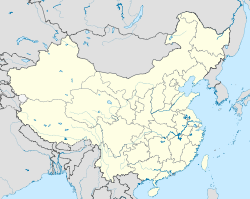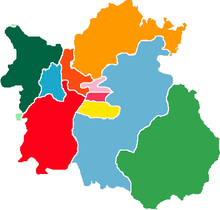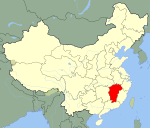- Nanchang
-
Nanchang
南昌— Prefecture-level city — 南昌市 Nanchang Nickname(s): Grand City (洪城)、Grand Capital (洪都)、Yuzhang (豫章) Nanchang City (yellow) in Jiangxi Location in China Coordinates: 28°41′N 115°53′E / 28.683°N 115.883°ECoordinates: 28°41′N 115°53′E / 28.683°N 115.883°E Country People's Republic of China Province Jiangxi Government – Mayor Hu Xian Area – Prefecture-level city 7,372 km2 (2,846.3 sq mi) – Urban 617 km2 (238.2 sq mi) Elevation 37 m (122 ft) Population (2010) – Prefecture-level city 5,042,565 – Density 684/km2 (1,771.6/sq mi) Time zone China Standard (UTC+8) City Flower Chinese Rose City Tree Camphor Laurel Website http://www.nc.gov.cn/ Nanchang Chinese 南昌 Hanyu Pinyin Nánchāng Literal meaning southern good Transcriptions Mandarin - Hanyu Pinyin Nánchāng Min - Hokkien POJ Lâm-chhiong Wu - Romanization na平 tshaon 平 Cantonese (Yue) - Jyutping naam4 coeng1 Nanchang (Chinese: 南昌; pinyin: Nánchāng; Mandarin pronunciation: [nǎntʂʰɑ́ŋ]) is the capital of Jiangxi Province in southeastern China. It is located in the north-central portion of the province. As it is bounded on the west by the Jiuling Mountains, and on the east by Poyang Lake, it is famous for its scenery, rich history and cultural sites. Owing to its central location relative to the Yangtze and Pearl River Delta regions, it is a major railroad hub in Southern China.
Contents
History
The city originally called (simplified Chinese: 赣; traditional Chinese: 贛; pinyin: Gàn) was founded and first walled in 201 BC (during the early Han dynasty), when the county town was given the name Nanchang. It was also the administrative seat of a commandery, Yuzhang. In 589 (during the Sui dynasty) this commandery was changed into a prefecture named Hongzhou (洪州), and after 763 it became the provincial center of Jiangxi, which was then beginning the rapid growth that by the 12th century made it the most populous province in China.
In 653 AD, the Tengwang Pavilion was constructed. In 675 AD, Wang Bo (王勃) wrote the classic "Tengwang Ge Xu". The building as well as the city became celebrated for Wang's introduction article and the author is known to all Chinese-speaking population by this masterpiece. The Pavilion has been destroyed and rebuilt several times throughout China's history. In its present form, Tengwang Pavilion was reconstructed in the 1980s after being destroyed in 1929 during the Chinese Civil War.
In 959, under the Southern Tang regime, it became Nanchang superior prefecture and also the southern capital. After the conquest by the Song regime in 981 it reverted to the name Hongzhou. In 1164 it was renamed Longxing superior prefecture, which name it retained until 1368. At the end of the Yuan (Mongol) period (1279–1368), it became a battleground between Zhu Yuanzhang, the founder of the Ming dynasty (1368–1644), and the rival local warlord, Chen Youliang. At the beginning of the 16th century it was the power base from which Zhu Chenhao, the prince of Ning, launched a rebellion against the Ming regime.
During the reign of the Wanli Emperor of the Ming dynasty, it housed relatives of the emperor who had been exiled because they were potential claimants of the imperial throne, members of the imperial family constituting about one quarter of the city's population; as a result of this, Matteo Ricci came here when trying to gain entry to Beijing.[1]
In the 1850s it suffered considerably as a result of the Taiping Rebellion (1850–64), and its importance as a commercial center declined as the overland routes to Canton were replaced by coastal steamship services in the latter half of the 19th century. Nanchang has, however, remained the undisputed regional metropolis of Jiangxi.
On August 1, 1927, Nanchang was the site of one of a series of insurrections organized by the Chinese Communist Party. The Nanchang Uprising, led by pro-communist Kuomintang officers under Russian direction, succeeded in holding the city for only a few days, and provided a core of troops and a method of organization from which the People's Liberation Army (PLA) later developed.
In 1939, the Battle of Nanchang, a ferocious battle between the Chinese National Revolutionary Army and the Japanese Imperial Japanese Army in the Second Sino-Japanese War took place.
In 1949 Nanchang was still essentially an old-style administrative and commercial city, with little industry apart from food processing; it had a population of about 275,000. Nanchang first acquired a rail connection in 1915, when the line to Jiujiang, a port on the Yangtze River, was opened. Several other rail links have since been opened. After World War II a line was completed to Linchuan and Gongqi in the Ru River Valley to the south-southeast.
Since 1949 Nanchang has been extensively industrialized. It is now a large-scale producer of cotton textiles and cotton yarn. Papermaking is also a large industry, as is food processing (especially rice milling). Heavy industry began to be important in the mid-1950s. A large thermal-power plant was installed and uses coal brought by rail from Fengcheng, to the south. A machinery industry also grew up, at first mainly concentrating on the production of agricultural equipment and diesel engines. Nanchang then became a center of the automotive industry, producing trucks and tractors and also such equipment as tires. An iron-smelting plant helping to supply local industry was installed in the later 1950s. There is also a large chemical industry, producing agricultural chemicals and insecticides as well as pharmaceuticals.
Geography and climate
Nanchang is located 130 km south of the Yangtze River and is situated on the right bank of the Gan River just below its confluence with the Jin River[disambiguation needed
 ] and some 40 km southwest of its discharge into Poyang Lake.
] and some 40 km southwest of its discharge into Poyang Lake.Nanchang has a monsoon-influenced humid subtropical climate (Koppen Cfa) with four distinct seasons. Winters are short and cool with occasional frosts; snow is not unheard of but heavy falls are otherwise rare. Summer is long and humid, with amongst the highest temperatures in China. Rain is greatest from March to June, and least in fall and early winter. Monthly averages in the city range from 5.3 °C (41.5 °F) in January to 29.2 °C (84.6 °F) in July, with an annual mean of 17.6 °C (63.7 °F).
Climate data for Nanchang (1971-2000) Month Jan Feb Mar Apr May Jun Jul Aug Sep Oct Nov Dec Year Average high °C (°F) 8.7
(47.7)10.4
(50.7)14.6
(58.3)21.2
(70.2)26.3
(79.3)29.4
(84.9)33.4
(92.1)33.0
(91.4)28.7
(83.7)23.7
(74.7)17.6
(63.7)12.1
(53.8)21.6 Average low °C (°F) 2.7
(36.9)4.4
(39.9)8.2
(46.8)14.3
(57.7)19.2
(66.6)22.8
(73.0)25.8
(78.4)25.6
(78.1)21.6
(70.9)16.3
(61.3)10.1
(50.2)4.6
(40.3)14.6 Precipitation mm (inches) 74.0
(2.913)100.7
(3.965)175.6
(6.913)223.8
(8.811)243.8
(9.598)306.7
(12.075)144.0
(5.669)128.9
(5.075)68.7
(2.705)59.7
(2.35)56.8
(2.236)41.5
(1.634)1,624.4
(63.953)% humidity 77 78 81 81 80 83 77 77 77 73 72 70 77.2 Avg. precipitation days (≥ 0.1 mm) 13.0 13.2 18.0 17.7 16.6 15.5 10.8 10.3 7.7 8.8 7.9 7.8 147.3 Sunshine hours 91.9 83.7 85.2 114.4 151.1 160.2 248.7 243.2 185.8 167.0 147.5 141.7 1,820.4 Source: 中国气象局 国家气象信息中心 Demographics
At the 2010 census, Nanchang has a population of 5,042,865 people and a built up area of about 3 million. 37 ethnic groups were counted amongst its prefecture divisions.
Administration
- Donghu District (东湖区)
- Xihu District (西湖区)
- Qingyunpu District (青云谱区)
- Wanli District (湾里区)
- Qingshanhu District (青山湖区)
- Honggutan New District (红谷滩新区)
- Nanchang County (南昌县)
- Xinjian County (新建县)
- Anyi County (安义县)
- Jinxian County (进贤县)
Economy
Nanchang is a regional hub for agricultural production in Jiangxi Province. The yield of grain was 16.146 million tons in 2000. Products such as rice and oranges are economic staples. The Ford Motor Company has a plant in Nanchang, assembling the Ford Transit van as part of the Jiangling Motor joint venture.[2] Many of its industry revolves around aircraft manufacturing, automobile manufacturing, metallurgy, electro-mechanics, textile, chemical engineering, traditional Chinese medicine, pharmaceuticals and others.[3]
The GDP of Nanchang in 2008 was 166 billion Yuan (24.3 billion USD). The GDP per capita was 36,105 Yuan (5,285 USD). The total value of imports and exports was 3.4 billion US dollars. The total financial revenue was 23 billion Yuan.[4]
Industrial zones
National level development zones[5]
- Nanchang Export Processing Zone
Nanchang National Export Expressing Zone is located in Nanchang Hi-Tech Industrial Development Zone, it was approved by the State Council on May 8, 2006, and passed the national acceptance inspection on Sep 7th, 2007. It has a planning area of 1 sqkm and now has built 0.31 sqkm. It enjoys simple and convenient customs clearances,and special preferential policies both for Nanchang National Export Expressing Zone and NCHDZ.[6]
- Nanchang National High-tech Industrial Development Zone
Nanchang National High-tech Industrial Development Zone (NCHDZ for short hereafter) is the only national grade high-tech zoned in Jiangxi, it was established in Mar. 1991. The zone covers an area of 231 square kilometers, in which 32 square kilometers have been completed. NCHDZ possesses unique nature condition and sound industry foundation of accepting electronics industry. NCHDZ has brought 25% industrial added value and 50% industrial benefit and tax to Nanchang city by using only 0.4% land area.[7]
- Nanchang Economic and Technological Development Zone[8]
Provincial level development zones[5]
- Jiangxi Sanghai Economic and Technological Development Zone
- Nanchang Yingxiong Economic and Technological Development Zone
Special economic district[5]
- Honggutan New District
Transportation
Rail
Nanchang has extensive railway infrastructure which connects to many important cities in other provinces. The Beijing-Jiulong Railway and Shanghai-Kunming Railway (formerly Zhe-Gan Railway, literally Zhejiang-Jiangxi Railway) both meet at Nanchang making Nanchang one of the most important transport hubs in Southern China. In addition, it is the only provincial capital located on the Jingjiu Railway. It is also the home to the Nanchang Bureau of Railways, which operates the majority of the railway network in the provinces of Jiangxi and Fujian.
From 2007, Nanchang is also connected with neighboring cities Hangzhou, Changsha and Shanghai with CRH (China Railway High-speed).
- Nanchang Changbei International Airport (南昌昌北国际机场)
- Beijing-Jiulong Railway (京九铁路)
- Shanghai-Kunming Railway (沪昆铁路)
- Nanchang Railway Station (南昌火车站)
Air
Nanchang Changbei International Airport (KHN) built in 1996 is the main international airport. It is situated in Lehua Town, 26 kilometres north of the CDB area. Changbei International Airport is the only one in Jiangxi Province which has an international air route. The airport is connected to major mainland cities such as Shenzhen, Guangzhou, Haikou, Shanghai and Beijing.[9]
Road
The road transport infrastructure in Nanchang is extensive. A number of national highways cross through the city. They are the National roads No.105 from Beijing to Zhuhai, No.320 from Shanghai to Kunming, and No.316 from Fuzhou to Lanzhou. The major transport companies that operate in Nanchang are the Chang'an Transport Company Limited, the Nanchang Long-distance Bus Station, and the Xufang Bus Station.
The Nanchang Long-distance Bus Station serves long distance routes to Nanjing, Shenzhen, Hefei and other cites outside Jiangxi Province. The Xufang Bus Station operates routes to cities, towns and counties within Jiangxi Province.[9]
Water
Nanchang is situated on the Gan River, the Fu River, Elephant Lake, Qingshan Lake, and Aixi Lake. Hence the water routes for Nanchang critically important for the economy, trade and shipping. Nanchang Port is the biggest port on the Gan River. Passengers can take Nanchang Port and travel by boat to the Jinggang Shan and Tengwang Pavilion. There are passenger ships that also visit Poyang Lake, Stone Bell Hill, Poyang Lake Bird Protection Area, Dagu Hill and other attractions.
Landmarks
 The Pavilion of Prince Teng is a building in the north west of the city of Nanchang, in Jiangxi province, China
The Pavilion of Prince Teng is a building in the north west of the city of Nanchang, in Jiangxi province, China
Nanchang is known for: The Tengwang Pavilion, a towering pavilion dating to 653,on the east bank of the Gan River and is one of "the Four Great Towers of China"
Poyang Lake, the largest fresh water lake in China, it is also called "the Migrator Birds Paradise".
It is also home to the Star of Nanchang, which was the world's tallest Ferris wheel from 2006-2008.[10]
The Jiangxi Provincial Museum and Bada Shanren Exhibition Hall.
Colleges and universities
- Jiangxi University of Finance and Economics (江西财经大学) (founded 1923)
- Nanchang University (南昌大学)
- Jiangxi Normal University (江西师范大学)
- Jiangxi Agricultural University (江西农业大学)
- East China Jiaotong University (华东交通大学)
- Nanchang Aeronautical University (南昌航空工业学院)
- Jiangxi Institute of Traditional Chinese Medicine (江西中医学院)
- Nanchang Institute of Technology (南昌工程学院)
- Jiangxi Science and Technology Normal University (江西科技师范学院)
- jiangxi Manufacturing and Vocational College (江西制造职业技术学院)
Note: Institutions without full-time bachelor programs are not listed.
International relations
Main article: List of twin towns and sister cities in ChinaTwin towns – sister cities
 Peine, Germany (October 13, 2009)[12]
Peine, Germany (October 13, 2009)[12] Skopje, Macedonia (March 20, 1984)
Skopje, Macedonia (March 20, 1984) Toluca, Mexico (August 16, 1988)
Toluca, Mexico (August 16, 1988) Takamatsu, Japan (March 20, 1984)
Takamatsu, Japan (March 20, 1984) Valkeakoski, Finland (March 20, 1984)
Valkeakoski, Finland (March 20, 1984) Toijala, Finland (March 20, 1984)
Toijala, Finland (March 20, 1984) Dijon, France (March 20, 1984)
Dijon, France (March 20, 1984) Naju, South Korea (March 20, 1984)
Naju, South Korea (March 20, 1984) Sorocaba, Brazil (March 20, 1984)
Sorocaba, Brazil (March 20, 1984)
References
- ^ Mary Laven, Mission to China: Matteo Ricci and the Jesuit Encounter with the East, ISBN 0571225179, 2011, p. 103
- ^ "Jiangling Motors Corporation, Ltd. website". http://www.jmc.com.cn/english/index.asp.
- ^ http://english.nc.gov.cn/aboutnanchang/economy/http://english.nc.gov.cn/aboutnanchang/economy/
- ^ Jiangxi
- ^ a b c http://english.nc.gov.cn/aboutnanchang/profile/
- ^ RightSite.asia | Nanchang Export Processing Zone
- ^ RightSite.asia | Nanchang High-Tech Industrial Development Zone
- ^ RightSite.asia | Nanchang Economic & Technological Development Zone
- ^ a b Nanchang Transportation, Get to the City: by Air, Train, Bus, Water
- ^ "China claims world's largest Ferris wheel - Boston.com". http://www.boston.com/news/odd/articles/2006/05/02/china_claims_worlds_largest_ferris_wheel/.[dead link]
- ^ http://english.nc.gov.cn/aboutnanchang/sistercity/
- ^ http://www.landkreis-peine.de/index.phtml?La=1&sNavID=1241.914&mNavID=1241.1038&object=tx%7C1241.3511.1&kat=&kuo=1&sub=0
External links
Jiangxi topics Nanchang (capital)General Geography Cities • Mufu Mountains • Jiuling Mountains • Luoxiao Mountains • Wuyi Mountains • Gan River • Lake Poyang • Yangtze River • Xiushui RiverEducation Jiangxi Normal University • Jiangxi Science and Technology Normal University • Jiangxi Agricultural University • Nanchang UniversityCulture Nanchang dialect • Yichun dialect • Ganju opera • Hakka dialect • Hakka architecture • Taoism • CuisineVisitor attractions Jiangxi Province county-level divisions Nanchang (capital)Nanchang: Donghu District · Xihu District · Qingyunpu District · Wanli District · Qingshanhu District · Nanchang County · Xinjian County · Anyi County · Jinxian County
Jingdezhen: Zhushan District · Changjiang District · Leping City · Fuliang County
Pingxiang: Anyuan District · Xiangdong District · Lianhua County · Shangli County · Luxi County
Jiujiang: Xunyang District · Lushan District · Gongqingcheng City · Ruichang City · Jiujiang County · Wuning County · Xiushui County · Yongxiu County · De'an County · Xingzi County · Duchang County · Hukou County · Pengze County
Xinyu: Yushui District · Fenyi County
Yingtan: Yuehu District · Guixi City · Yujiang County
Ganzhou: Zhanggong District · Ruijin City · Nankang City · Gan County · Xinfeng County · Dayu County · Shangyou County · Chongyi County · Anyuan County · Longnan County · Dingnan County · Quannan County · Ningdu County · Yudu County · Xingguo County · Huichang County · Xunwu County · Shicheng County
Ji'an: Jizhou District · Qingyuan District · Jinggangshan City · Ji'an County · Yongfeng County · Yongxin County · Xingan County · Taihe County · Xiajiang County · Suichuan County · Anfu County · Jishui County · Wan'an County
Yichun: Yuanzhou District · Fengcheng City · Zhangshu City · Gao'an City · Tonggu County · Jing'an County · Yifeng County · Fengxin County · Wanzai County · Shanggao County
Fuzhou: Linchuan District · Nanfeng County · Le'an County · Jinxi County · Nancheng County · Dongxiang County · Zixi County · Yihuang County · Guangchang County · Lichuan County · Chongren County
Shangrao: Xinzhou District · Dexing City · Shangrao County · Guangfeng County · Poyang County · Wuyuan County · Qianshan County · Yugan County · Hengfeng County · Yiyang County · Yushan County · Wannian CountyMetropolitan cities of the People's Republic of China Municipalities and National central cities Regional central cities Special administrative regions Sub-provincial cities (not included above) Separate state-planning cities (not included above) Provincial capitals (not included above) Autonomous regional capitals Comparatively large cities (not included above) Special economic zone cities (not included above) Coastal development cities (not included above) XPCC / Bingtuan cities State-level new areas Pudong New Area (Shanghai) · Binhai New Area (Tianjin) · Liangjiang New Area (Chongqing) · Zhoushan Archipelago New Area (Zhoushan)Provincial capitals of the People's Republic of China Changchun, Jilin · Changsha, Hunan · Chengdu, Sichuan · Fuzhou, Fujian · Guangzhou, Guangdong · Guiyang, Guizhou · Haikou, Hainan · Hangzhou, Zhejiang · Harbin, Heilongjiang · Hefei, Anhui · Hohhot, Inner Mongolia · Jinan, Shandong · Kunming, Yunnan · Lanzhou, Gansu · Lhasa, Tibet · Nanchang, Jiangxi · Nanjing, Jiangsu · Nanning, Guangxi · Shenyang, Liaoning · Shijiazhuang, Hebei · Taiyuan, Shanxi · Ürümqi, Xinjiang · Wuhan, Hubei · Xi'an, Shaanxi · Xining, Qinghai · Yinchuan, Ningxia · Zhengzhou, Henan
Dongcheng District (Beijing) · Yuzhong District (Chongqing) · Huangpu District (Shanghai) · Heping District (Tianjin)
 Categories:
Categories:- Cities in Jiangxi
- 201 BC establishments
- Provincial capitals in China
- Nanchang
Wikimedia Foundation. 2010.









